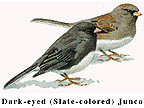Millions served (birdseed) as Cornell's Project FeederWatch begins second decade
By Roger Segelken
ITHACA, N.Y. -- The best place to go eye-to-eye with a dark-eyed junco -- or to be eaten out of house and home by a hungry house finch while becoming comfortable with a downy Woodpecker -- could be your backyard, kitchen window or balcony bird feeder.
Statisticians at the Cornell Laboratory of Ornithology, where the world's largest citizen science program, Project FeederWatch, is based, have just released the 1997 Top 10 List of Feeder Birds. The annual list is used by professional ornithologists to track trends in bird populations. Just as interested are the more than 11,000 registered FeederWatchers and thousands of other backyard "birders" who compare their findings with others' across North America.
From the number-crunchers at the Cornell Laboratory of Ornithology, who processed 69,785 Project FeederWatch data forms, here are the 10 most widespread feeder species in North America (See attached list for the top 39):
10. European Starling
9. Northern Cardinal
8. House Sparrow
7. Black-capped Chickadee
6. Mourning Dove
5. Blue Jay
4. Downy Woodpecker
3. American Goldfinch
2. House Finch
1. Dark-eyed Junco
"The most noticeable decline was in the numbers of house finches appearing at individual feeders in the East," said Diane L. Tessaglia, Project FeederWatch research coordinator at the Cornell Laboratory of Ornithology. "We had the same number of FeederWatchers reporting House Finches, but the average flock size dropped 22 percent between the winter of 1995-96 and last winter. Although house finches have been appearing at more feeders continentwide since 1987-88, their numbers in the East have been declining since 1992-93."
Volunteer FeederWatchers keep tabs on visiting birds during the winter feeding season, which begins as early as November each year and continues through April. The latest results are for the winter of 1996-97. Project FeederWatch is a joint project of the Cornell Laboratory of Ornithology and the National Audubon Society in the United States and Bird Studies Canada and the Canadian Nature Foundation in Canada.

Last winter's FeederWatch results also should provide some solace for Eastern birders who saw relatively few birds at their feeders. The winter of 1996-97 was a "bad" year in the East for people who like to see large numbers of birds at their feeders, Tessaglia said, commenting on reports from the East and the West's higher-than-normal incursions that ornithologists call "irruptions."
"Irruptive species were practically absent from the East, and a mild winter resulted in fewer resident birds at feeders," Tessaglia said. "But for FeederWatchers in the West, it was an exciting year. Most of the irruptive species were found in California and the Southwest."

Bird-population scientists study irruptions and try to determine their cause, which often is related to weather conditions and food supplies far from the FeederWatchers' feeders. The last time the East experienced a major irruption was the winter of 1995-96, when unusually large numbers of red-breasted nuthatches, pine siskins, evening grosbeaks and common redpolls were documented. Most ornithologists attributed the "red invasion" to severe weather and seed shortages in Canada.
Beginning this winter, FeederWatch will be able to submit their data electronically via the Internet. Interested bird-watchers can visit the FeederWatch data-submission demonstration site via the Laboratory's Web site: http://www.ornith.cornell.edu.

That Web site also has information on joining Project FeederWatch. An annual fee of $15 helps cover costs of data analysis and newsletters sent to FeederWatchers. Information on joining Project FeederWatch is available by calling 1-800-843-BIRD, a toll-free call in the United States, or (519) 586-3531 from Canada. The address in the United States is the Cornell Laboratory of Ornithology, Project FeederWatch, P.O. Box 11, Ithaca, N.Y. 14851-0011. In Canada write Bird Studies Canada, P.O. Box 160, Port Rowan, Ontario, N0E, 1M0, Canada.

The most widespread feeder species in North America in the winter of 1996--97.
This table lists all species that visited at least 25 percent of all feeders, plus 14 other species (below line) that showed meaningful continent-wide trends
Percentage Mean number Mean
of feeders per feeder group size,
visited per week when seen
Dark-eyed Junco 83.03 1.90 4.40
House Finch 70.12 1.55(-22%) 4.86(-13%)
American Goldfinch 69.50 1.37(-12%) 4.79
Downy Woodpecker 69.10 0.43 1.34
Blue Jay 66.52 0.76 2.35
Mourning Dove 64.91 1.40 3.79
Black-capped Chickadee 59.62 1.13 2.75
House Sparrow 59.45 1.35 6.48
Northern Cardinal 56.36 1.16(-11%) 2.71
European Starling 52.59 0.36(-11%) 3.79(-12%)
American Robin 50.86 0.12 2.05
White-breasted Nuthatch 46.07 0.22(-17%) 1.34
Hairy Woodpecker 41.49 0.15(+14%) 1.19
Tufted Titmouse 40.93 0.44 1.92
Red-bellied Woodpecker 37.82 0.16 1.14
American Crow 37.32 0.14 2.43
Common Grackle 35.18 0.11(-31%) 3.71(-27)
Northern Flicker 34.97 0.08 1.18
Purple Finch 34.42 0.10(-47%) 2.66
Pine Siskin 31.15(-37%) 0.18(-85%) 3.26(-19%)
Song Sparrow 30.40 0.08(-22%) 1.51
Red-winged Blackbird 30.28(-14%) 0.08(-32%) 3.47(-17%)
White-throated Sparrow 29.66(-12%) 0.20(-41%) 2.09
Red-breasted Nuthatch 26.28(-44%) 0.10(-47%) 1.37
Carolina Wren 25.83(-10%) 0.10(-26%) 1.22
-----------------------------------------------------------------------
Brown-headed Cowbird 21.66(-14%) 0.04(-41%) 3.27
Sharp-shinned Hawk 19.96(-11%) 0.02 1.01
American Tree Sparrow 19.75(-18%) 0.07(-25%) 2.54
Evening Grosbeak 16.66(-17%) 0.09(-37%) 5.22
White-crowned Sparrow 16.39 0.13(+26%) 2.34(-14%)
Chipping Sparrow 15.10(-10%) 0.05 1.99(-29%)
Mountain Chickadee 10.51(+44%) 0.06(+69%) 2.05
Steller's Jay 10.26(+15%) 0.05(+22%) 1.75(-12%)
Fox Sparrow 10.14(-36%) 0.01(-69%) 2.27(+47%)
Common Redpoll 9.20(-102%) 0.09(-133%) 4.08(-17%)
Cassin's Finch 8.07 0.07(+85%) 3.73
Bohemian Waxwing 5.08(+41%) 0.02(+69%) 18.80(+50%)
Varied Thrush 4.76 0.02(+69%) 1.49(-13%)
Harris's Sparrow 4.64(+16%) 0.02(+69%) 2.50
Media Contact
Get Cornell news delivered right to your inbox.
Subscribe